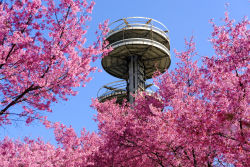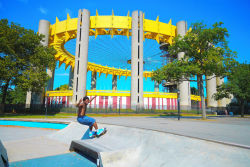Flushing Meadows Corona Park
The Daily Plant : Tuesday, July 2, 2002
PARKS SHOWS OFF ITS "QUEENS JEWELS"

Some people may say that Queens is a diamond in the rough, but Parks knows better. Last Wednesday, June, 26, Commissioner Adrian Benepe welcomed a crowd more than one hundred and fifty guests to the Arsenal Gallery for the opening of "Queens Jewels: A History of Queens Parks." Curated by Director of Arts & Antiquities Jonathan Kuhn, the exhibition tells the borough’s story through photographs, historic renderings, artifacts and memorabilia from the Parks Photo Archive and historical collections, and vintage postcards on loan from the excellent collection of the Long Island Division of the Queens Central Library. Kuhn commented, "This is the latest in a series of exhibitions based on Parks history that which we’ve staged each summer for the last 18 years in the Arsenal Gallery. As MoMA goes to Queens, we brought Queens to Manhattan."
Public Art Coordinator Adrian Sas, Graphic Designer Dana Wilner, Photo Archivist Sachiko Onishi, and Historian Scott Sendrow worked on the show and the accompanying brochure featuring 16 pages of text and photographs detailing the rich history of Queens parks. Councilman Joseph Addabbo and former Queens Borough President Claire Schulman were on hand for the opening, as were Deputy Commissioner for Capital Projects Amy Freitag and Deputy Commissioner for Operations Liam Kavanagh. Queens Parks were well represented by Borough Commissioner Richard Murphy, Queens Chief of Staff JoAnne Amagrande-Savarese, Assistant Commissioner for Flushing Meadows-Corona Park Estelle Cooper, and Queens Deputy Chief of Operations Lee Henry. Sarah Howell, BP’s Director of Environmental & Corporate Communications represented the corporate sponsor, which donated the $7,000 that funded both the exhibition and the brochure. Queens restaurants Native, Uncle Peter's and Terrace on the Park donated the evening’s refreshments.
"In fact," Commissioner Benepe explained, "there are only 100 years of anything in ‘Queens.’" Prior to the consolidation of the five boroughs of New York City in 1898, Queens was primarily rural, a collection of disconnected villages and towns that more closely resembled Nassau County than Brooklyn. The idea of Queens as a cohesive community was a political invention, not grounded in its social history or geography. At that time, Queens had no parks system, only a scattering of town greens and squares. Today, the largest borough in size and the second most populous boasts more than 7,000 acres of green space. The show illustrates the range of features and activities in Queens Parks from its origins to now, reflecting the dramatic evolution of the borough during the 20th century into the urban and diverse community it is today.
"We selected photographs that capture some defining moments in Queens history, but we also wanted to draw attention to the continuity between the past and present," Kuhn explained, "The aesthetics often change, but the ways that people use the parks have changed very little." The collection of over seventy images includes photographs of early street tree care in Flushing, a lumber camp in Forest Park, the first Queens playground (Ashmead Playground), and floral displays in Long Island City. The era of Parks Commissioner Robert Moses (1934-1960) is well-represented with images of smiling children at new WPA playgrounds, the spectacular Astoria Park Pool, Rockaway Beach and boardwalk, and the transformation of Flushing Meadow into the borough’s premiere park, which hosted two World’s Fairs and the United Nations. Striking views of forests and wetlands, then and now, highlight the many natural sanctuaries of Queens. Objects in the exhibit include a 1941 bronze sculpture bust of Walter Cunningham (for whom Cunningham Park is named), an official World’s Fair Souvenir Guide, entries from a children’s essay contest on the need for a playground in Richmond Hill, and a range of park improvement reports and visitor guides from the 1930s to now.
"Queens Jewels" runs through September 5, 2002, Monday through Friday from 9:00 a.m. to 5:00 p.m. If you can’t make it to the show, you can view the exhibition’s "outtakes" on the internet at www.nyc.gov/parks.
Written by Jennifer Keeney
THIRTEEN YEARS AGO IN THE PLANT
(Tuesday, July 11, 1989)
GOTHAM FLIPS OVER FLOATING FLICKS
Forget Batman. We’ll take Roger Rabbit, the love-sick, whimsical hero of last summer’s hit "Who Framed Roger Rabbit?" The cartoon character was shot, punched, crunched, sliced, and diced (to no ill effect) by Dr. Doom and several assorted villains. This summer, New Yorkers will see the carrot-cruncher walk in water when the Floating Cinema brings "Roger Rabbit" and other flicks to a shoreline near you for the second year in a row.
"On the Waterfront" will launch the free Floating Cinema season at the Admiral Dewet Promenade (near Pier A) at Battery Park in Manhattan this Friday at 8:30 p.m. The series will show 25 feature-length films at park sites throughout the five boroughs. Viewers are advised to bring blankets, beach chairs and flashlights.
QUOTATION FOR THE DAY
"The only disability in life is a bad attitude."
Scott Hamilton
(b. August 28, 1958)












